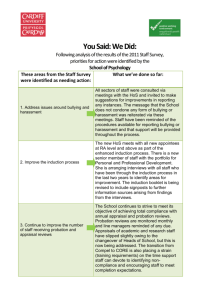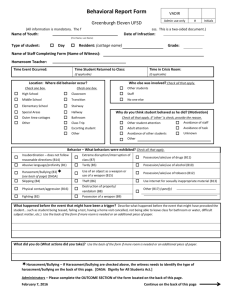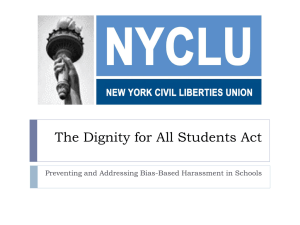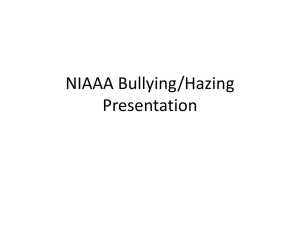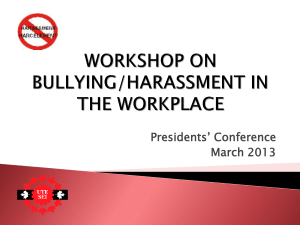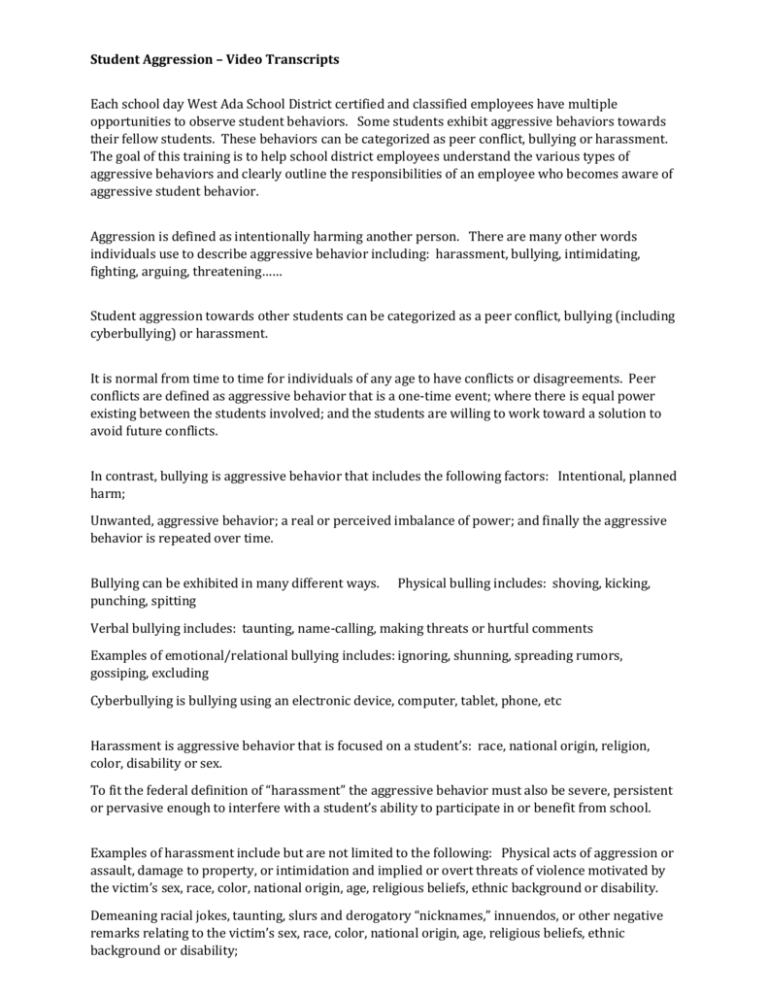
Student Aggression – Video Transcripts
Each school day West Ada School District certified and classified employees have multiple
opportunities to observe student behaviors. Some students exhibit aggressive behaviors towards
their fellow students. These behaviors can be categorized as peer conflict, bullying or harassment.
The goal of this training is to help school district employees understand the various types of
aggressive behaviors and clearly outline the responsibilities of an employee who becomes aware of
aggressive student behavior.
Aggression is defined as intentionally harming another person. There are many other words
individuals use to describe aggressive behavior including: harassment, bullying, intimidating,
fighting, arguing, threatening……
Student aggression towards other students can be categorized as a peer conflict, bullying (including
cyberbullying) or harassment.
It is normal from time to time for individuals of any age to have conflicts or disagreements. Peer
conflicts are defined as aggressive behavior that is a one-time event; where there is equal power
existing between the students involved; and the students are willing to work toward a solution to
avoid future conflicts.
In contrast, bullying is aggressive behavior that includes the following factors: Intentional, planned
harm;
Unwanted, aggressive behavior; a real or perceived imbalance of power; and finally the aggressive
behavior is repeated over time.
Bullying can be exhibited in many different ways.
punching, spitting
Physical bulling includes: shoving, kicking,
Verbal bullying includes: taunting, name-calling, making threats or hurtful comments
Examples of emotional/relational bullying includes: ignoring, shunning, spreading rumors,
gossiping, excluding
Cyberbullying is bullying using an electronic device, computer, tablet, phone, etc
Harassment is aggressive behavior that is focused on a student’s: race, national origin, religion,
color, disability or sex.
To fit the federal definition of “harassment” the aggressive behavior must also be severe, persistent
or pervasive enough to interfere with a student’s ability to participate in or benefit from school.
Examples of harassment include but are not limited to the following: Physical acts of aggression or
assault, damage to property, or intimidation and implied or overt threats of violence motivated by
the victim’s sex, race, color, national origin, age, religious beliefs, ethnic background or disability.
Demeaning racial jokes, taunting, slurs and derogatory “nicknames,” innuendos, or other negative
remarks relating to the victim’s sex, race, color, national origin, age, religious beliefs, ethnic
background or disability;
Graffiti and/or slogans or visual displays such as drawings, cartoons or posters depicting slurs or
derogatory sentiments related to the victim’s sex, race, color, national origin, age, religious beliefs,
ethnic background or disability;
Research has identified the following “Best Practices” for prevention of aggressive student
behaviors including bullying and harassment:
Consistent student supervision. A well designed and implemented supervision plan includes
supervision of classroom and non-classroom environments. Non classroom environments include
hallways, stairways, lunch rooms, locker rooms, bus lines and other outside areas in which students
gather or spend time.
School-Wide Positive Behavioral Supports also known as Behavior RtI is built upon 3-5 simple
School Wide Rules that all adults agree to and teach students. The school wide rules typically
include being safe and respectful at all times. School wide positive behavioral supports also
implements a system of reinforcement for positive behaviors;
Another “best practice” to prevent aggressive behavior in students is to:
Empower bystanders in other words to teach students to inform adults when they observe bullying
or harassment.
Finally, it is also important to:
Empower targets of bullying to report to adults when they have been bullied or harassed.
Who decides if the student aggression is bullying, harassment or a peer conflict? In most cases
school administrators will make the determination. But, in some extreme cases the police or other
legal authorities will be determining the type of behavior and consequences that will be paid by the
students involved.
It is the responsibility of all West Ada certified and classified staff members to ensure the safety of
our students.
Staff then are expected to: held educate students about aggressive behaviors including bullying and
empower students to stand up for targets of aggressive behaviors including bullying and to report
this to the nearest adult. Staff should clearly express disapproval of all types of aggressive
behavior.
Staff should also be vigilant and aware of student behavior especially aggressive behavior. It is
imperative that staff provide consistent and thorough supervision of students. Staff should
immediately intervene in situations where students are being aggressive physically and verbally.
Staff are mandated by district policy to report student aggression to an administrator. Remember
to ask the students involved in the aggression if this type of behavior has occurred before. A
pattern of aggression could mean that the student is being bullied.
District employees are encouraged to familiarize themselves with district policies including the two
student policies 502.7 Student Harassment/Relationship Abuse and 502.9 Bullying
As well as staff policies 403.71 Harassment and 403.73 Bullying.
Additional information on this subject can also be found in Idaho Code 18-917A



